Recent Water Damage Posts
Do You Know Where Your Water Shut-Off Valves Are?
3/16/2021 (Permalink)
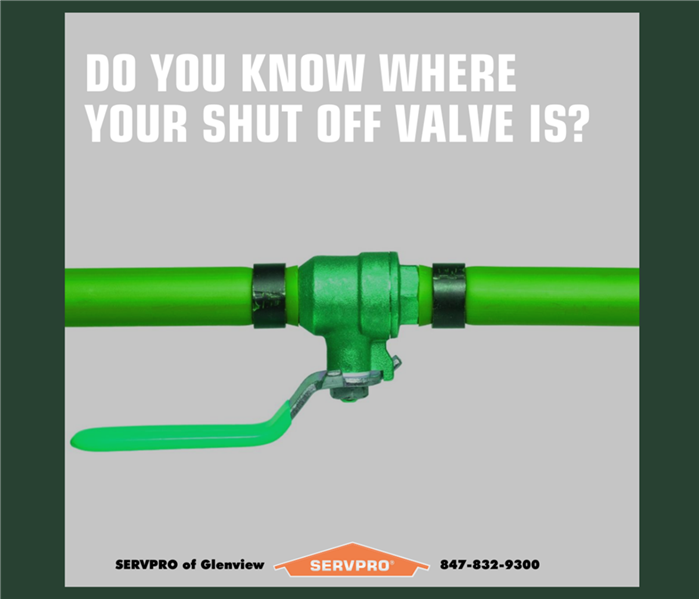 A smart homeowner or business owner will always be prepared by learning where the shut-off valves are located
A smart homeowner or business owner will always be prepared by learning where the shut-off valves are located
One of the things many of us take for granted is our home, or more specifically, how our home just always "works" and doesn't fail us.
Until that unfortunate day when your home does fail you. There are many ways you might experience a breakdown in your home, but one of the most damaging is when your plumbing, piping, or water delivery system fails. Or perhaps it's not even the plumbing itself that failed, but a water-fed appliance, such as your dishwasher, washing machine, refrigerator, or even your water heater.
It is mind-boggling to see the amount of untold damage and the speed at which damage happens when a pipe or appliance breaks. Think what damage could happen when you are in the home when the failure occurs. Now think how much initial damage and secondary damage will occur if you aren't there? What will happen and how long will it go on if you are gone on for several hours or even out of town over the weekend?
Water will continue to flow through your piping and out at the point of failure until it is stopped, or turned off. Water will continue to pour into your home, damaging the room, the floor, the walls, perhaps the ceiling, and all the contents, furniture, and belongings in that room. And possibly even flowing into and damaging the next room or the floor below.
If ever a pipe bursts or a water-fed appliance fails in your home (or business), the very first step you must take is to turn off the water! This could be a localized shut-off valve, such as below a sink or behind a toilet or refrigerator or other appliance, or you may need to turn off the main water valve to your home.
Unfortunately, very few homeowners (or business owners) take the time to learn where their emergency shut-off valves are, but knowing where the valves are and how to turn them off can greatly minimize the amount of damage done to property and belongings if a pipe bursts or appliance fails.
Turning your water off before you leave for an extended period of time such as a vacation or the weekend can seem like such a small and unlikely preparation, and yet that act alone can be the difference between avoiding disaster entirely or thousands or even tens of thousands of dollars in damage to your home or business.
Take the time to educate yourself where these shut-off valves are. Remember to shut the water off before you leave for prolonged periods of time to give yourself that extra measure of protection.
Whether you are home if it happens or not, should disaster strike and you find a burst water pipe or failed appliance has left you with a soggy mess, FIRST SHUT OFF YOUR WATER VALVE, then call on the professionals of SERVPRO of Glenview to mitigate, cleanup, and restore your home or business.
Act Now to Prevent Pipes from Freezing This Winter
11/10/2020 (Permalink)
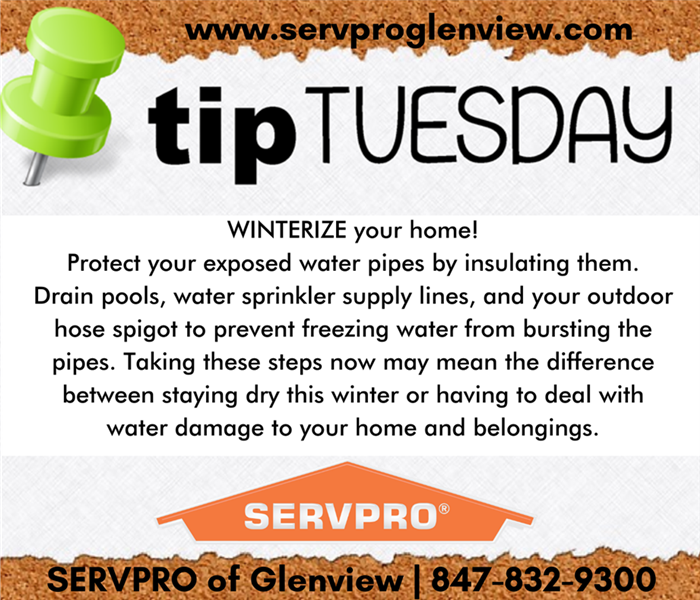 Don't delay! Act today to prevent your water pipes from freezing this winter!
Don't delay! Act today to prevent your water pipes from freezing this winter!
Each November, many Glenview-area residents can be found outside working around their homes. Reading this, what comes to mind for most folks is that homeowners are outside in November, either taking down Halloween decorations or putting up Christmas lights, inflatables, and other yard decorations.
While decorating your home for the holidays is a festive chore, Midwest homeowners should not overlook the regular home maintenance that should be done in order to winterize your home. Before the onset of the cold winter weather, be sure to protect your water pipes from freezing by taking the time to do these simple chores.
If you have an outdoor swimming pool, hot tub or jacuzzi, or have a lawn sprinkler system, be sure to drain water from your pool, tub, or sprinkler supply lines by following the manufacturer's or installer's directions. Do not put antifreeze in these lines unless specifically directed to do so. Not only is antifreeze environmentally harmful, it is dangerous to humans, pets, and landscaping. It is important to keep antifreeze out of our public sanitation and sewage lines.
While not every home will have a pool, but certainly most homes will have an outdoor water spigot and hose. To winterize your outdoor hose bib (spigot/faucet), close inside valves supplying the outdoor hose bib. Open the outside hose bib to allow water to drain. Remember to keep the outside valve open through the winter so that any water remaining in the pipe can expand without causing the pipe to break. Lastly, drain, remove, and store any hoses you've used outdoors by keeping them in a shed or garage. If you must store your hoses outdoors, be sure they are fully drained so the water does not freeze and expand and crack the hose over the winter.
Be sure to check around your home for other areas where supply lines by be located in unheated areas. Check areas such as your garage, attic, basement, and crawl space. Add insulation to these areas to help maintain higher temperatures which will help prevent freezing.
Look for areas where your water supply lines are exposed, such as under kitchen and bathroom cabinets, especially if the cabinets are located against an exterior wall. Both hot and cold water pipes in these areas should be insulated.
Consider installing specific products to insulate water pipes. Installing pipe sleeves, or UL-listed heat tape, heat cable, or similar materials on exposed water pipes can greatly reduce the likelihood of those pipes freezing and bursting.
If you are in an area that does not usually have frequent or prolonged temperatures below freezing, know that even a 1/4 inch of newspaper can provide some degree of insulation and significant protection to exposed pipes, if you are weighing your cost-to-benefit ratio.
If you have experienced freezing or burst pipes in the past, and protecting the exposed pipes has not proved to be effective, a more costly option, if possible, would be to relocate the exposed pipes to provide increased protection from heating.
Take preventative measures this month by doing regular home maintenance such as draining exterior water lines, or by insulating and protecting exposed pipes. When the frigid temps of winter come, you will rest easier knowing you have taken steps to prevent your pipes from freezing.
Should the unthinkable happen and your water pipes freeze and then burst, know you can count on SERVPRO of Glenview to respond to your call for help with the resulting water loss. Call us 24/7 at 847-832-9300. Whether your winter water damage is a result of a burst pipe, a frozen water dam in your gutters, or a failed appliance, our SERVPRO team of technicians are always Here to Help®.
What Kind of Damage Can Floods Do to a House?
11/2/2020 (Permalink)
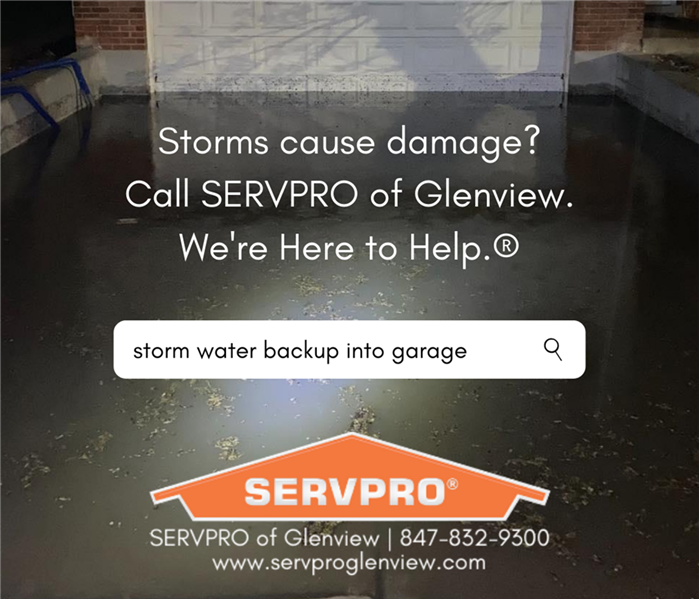 Flood damage from spring storms, heavy rains, and overloaded drainage networks can wreak havoc on your home and property.
Flood damage from spring storms, heavy rains, and overloaded drainage networks can wreak havoc on your home and property.
Flooding can wreak utter havoc on your Glenview home and the best thing you can do about it is to call a good flood damage remediator, like SERVPRO of Glenview.
Glenview and Northbrook, like many other North Shore Chicago communities, often seem like the setting of a John Hughes film, because they ARE!. The idyllic suburban atmosphere and manicured greenery can trick local homeowners into thinking disasters could never happen in their neighborhood, but this is not the case and flooding can be a fairly common occurrence here. Unfortunately, living in a North Shore community is not like life in the movies!
What usually causes flooding in our area?
Flood damage in Glenview generally results from the effects of heavy rains that often impact the Midwest region each spring and early summer. These swell the nearby Des Plaines River and overflow local ponds and creeks. Since this area is mostly flat, this excess water quickly rises to levels that affect local homes and businesses. Gutters and town drainage networks get clogged by common debris and yard waste, and these networks then spill out onto nearby lands and inundate residences and commercial properties. Whenever this happens, it is necessary to call an experienced flood damage cleanup and restoration service such as SERVPRO of Glenview.
How do the standing waters of a flood affect your home?
At SERVPRO, our professionals have seen the many effects of standing floodwaters on homes and their contents. Some of these develop almost immediately after flooding occurs, while others develop over time. A few common issues resulting from standing floodwaters include:
- buckled or collapsed floors
- warped walls
- disintegrating drywall and plaster
- discoloration or corrosion of surfaces
- dirty water that is trapped behind walls and in other difficult-to-access areas
- backed up sewage systems
These severe problems require the assistance of trained professionals who know what they are doing. Otherwise, costly mistakes could be made, wasting both time and money.
Is it possible to save household contents impacted by floodwaters?
Most often, contents coming into contact with floodwaters are not salvageable due to the fact that these waters are considered to be the most contaminated type of water. They are usually filled with the most hazardous pollutants like animal carcasses, human and animal wastes, toxic chemicals, trash of all kinds, and dangerous microbes. However, SERVPRO is sometimes able to save irreplaceable valuables, such as expensive Persian rugs, damaged by floodwaters by employing innovative methods, industrial-grade washing and drying equipment, and enzyme and chemical-free soaps.
What effect do flood-borne microbes have on your home?
As previously noted, floods bring with them harmful microbes. These microorganisms could affect your property in many ways, as you can imagine. The effects vary in severity and can impact everything from the superficial aesthetics to the structural integrity of your home. Some of the most notable of these effects are:
- mold/mildew stains and other discoloration on floors, baseboards, walls, and ceilings
- strong musty or otherwise foul odors that are difficult to neutralize
- dry rot that develops over time and undermines the structural integrity of your residence
- harmful bacteria growths that could cause health effects
It is important to realize that each of these potential issues becomes much more likely the longer you wait to have your home remediated. Moreover, if these effects already do exist, they worsen over time if not properly addressed.
How does SERVPRO resolve the various effects of flooding?
SERVPRO of Glenview has the necessary expertise and all the latest state-of-the-art tools to successfully resolve your flood-related issues. For years, we have tackled numerous problems associated with standing floodwaters and the dangerous microbes they carry. Our technicians have done this with:
- powerful extractors and pumps that rapidly remove gallons of standing water from structures
- professional hazardous waste disposal methods that are safe for both residents and the environment
- advanced high-velocity fans, air movers, and dehumidifiers that quickly reduce interior humidity to normal levels
- cutting edge Injectidry systems and floor pads that can remove water from difficult-to-access areas behind ceilings and walls, as well as under floorings
- high-tech foggers that can fill impacted air and materials with EPA-approved antimicrobials and deodorants
Using all of these impressive resources, SERVPRO experts are usually able to return your home to its pre-flood condition in record time.
If and when flooding damages your residence, remember that not all is lost. There is high-quality help available nearby! Call SERVPRO of Glenview at 847-832-9300 whenever you need our assistance dealing with flood damage.
SERVPRO of Glenview, Your 24-hr Emergency Water Damage Service
8/19/2020 (Permalink)
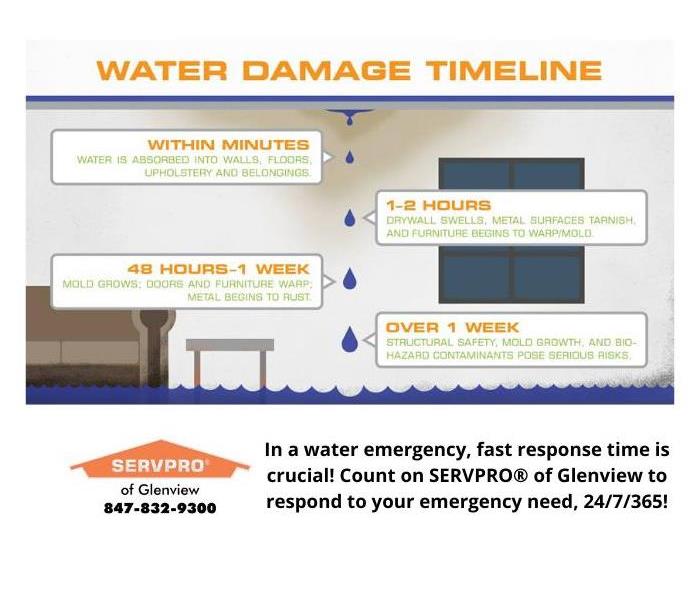 Response time is critical following water damage. Call on the experts at SERVPRO of Glenview ASAP! We're here 24/7/365 and ready to help!
Response time is critical following water damage. Call on the experts at SERVPRO of Glenview ASAP! We're here 24/7/365 and ready to help!
SERVPRO of Glenview is available to respond to water emergencies, large or small, 24 hours a day, 7 days a week, 365 days a year. When you are dealing with water damage, immediate action is crucial. A delay of just a few hours can greatly increase the severity of the water damage.
Call when you need us - (847) 832-9300
We understand that when you call us with a water emergency, you may be feeling stressed, confused, or vulnerable. You need an expert to guide you though this crisis. SERVPRO of Glenview has the specific water damage training and expertise to help you through this tough time. We specialize in water damage cleanup and restoration - in fact, that's the cornerstone of our business.
What to expect when you call us
When you call us we will ask several questions regarding your water emergency and damage. These questions help us determine what course of action needs to be taken, such as what equipment and resources to bring, including how many trained SERVPRO professionals may be needed.
Our SERVPRO representative will ask several questions, including:
- Your name and contact information (address, phone number/s, email)
- The street address of the water-damaged home or business
- When the flooding or water damaged occurred
- What caused the water damage (if known)
- Whether there is electricity available on-site
- Your insurance information (if applicable)
About SERVPRO of Glenview
SERVPRO of Glenview specializes in the cleanup and restoration of residential and commercial properties after a fire, smoke, water, or storm damage event. Our staff is highly trained in property damage restoration. From initial and ongoing training at SERVPRO's corporate training facility to regular IICRC-industry certification, rest assured our staff is equipped with the knowledge to restore your property.
Flooded? Follow these safety tips!
6/4/2020 (Permalink)
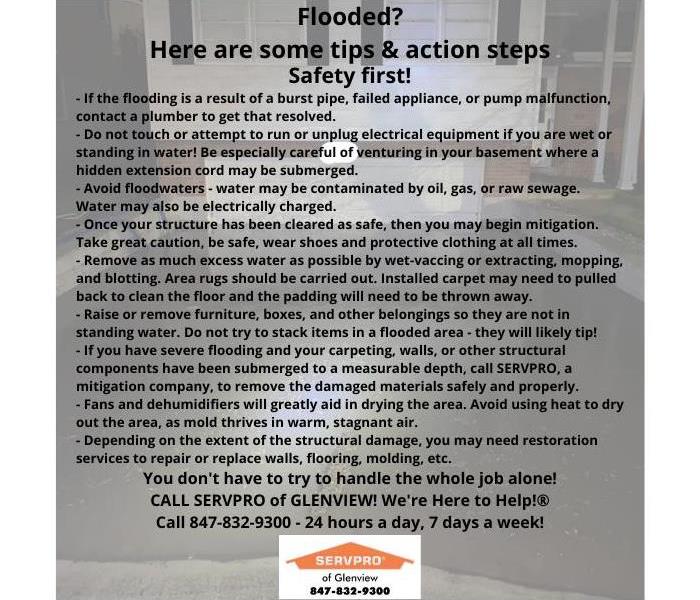 At some point in your life, you may experience a flood in your home, whether large or small. Here are some safety tips and action steps to follow.
At some point in your life, you may experience a flood in your home, whether large or small. Here are some safety tips and action steps to follow.
Flooded???
Whether your home is a single-residence house, a townhome, a condo, an apartment, or even a cabin, dealing with a flood should follow a similar timeline.
First and foremost: YOUR SAFETY! Account that all family members or residents (including pets) are safe! If this is a major flood event, you may have to evacuate your residence. If water enters the building making evacuation impossible, move to an upper floor or higher area and wait for rescuers.
A note on driving safety: If you evacuated, do not attempt to drive through floods or rising waters! Nearly half of all flash flood fatalities are auto-related.
A flood in your home can occur for many reasons. Storm damage is a big reason: a storm, a flash flood, backed up sewers or storm drains, storm damage to the home that allows water indoors (such as a hole in the roof or a broken window). Storm damage can wreak havoc on your home, bringing in as little as an inch, or worse - water measured in feet.
Water damage can also occur due to something inside the home failing:
- a burst pipe (whether it was frozen or not)
- a failed hose, valve, or coupling
- an appliance malfunction (such as a broken dishwasher, washing machine, water heater, or refrigerator)
- a pump that failed to function properly (whether it's a sump pump or an ejector pump)
- an overflowing toilet or a "stuck" faucet that caused a sink, tub, or shower to overflow
Obviously, water and storm damage caused by nature is out of your control. You can only wait it out. Only once the storm is over and the flood waters have begun to recede can you begin to take stock of the damage and begin the mitigation and reconstruction processes.
However, when you have an event that is not of natural causes, such as that occurs when pipes burst or appliances fail, it is imperative to stop the water at the source. You may need to turn off the water supply, either to a specific appliance or area or to the whole home, by turning off the water shutoff valve. Once the water has been stopped, you need to take steps to fix the problem. Likely your first call will be to a plumber.
Once the source of the water has been addressed, you can then assess the damage. If you were present at the time of the water damage, perhaps you were able to prevent the water from soaking your furniture and belongings by moving them to drier areas. But if the water damaged structural components of your home - flooring, walls, molding/trim, stairs, doors - as well as your belongings, then the mitigation ahead is much larger, and perhaps beyond your abilities to handle.
When in doubt, call in the professionals! Support your local SERVPRO! We are Here to Help® 24/7/365. SERVPRO teams are Fire & Water - Cleanup & Restoration™ experts!
If you are in the near North and Northwest suburbs of Chicago, the crews of SERVPRO of Glenview may be your nearest mitigation specialists! Call us when you need us and we'll be there to help make it Like It Never Even Happened.
Call 847-832-9300 to speak to a SERVPRO of Glenview team member about your emergency water damage needs.
In the meantime, if you should find yourself dealing with a flood in your home, try to remember these safety tips and action steps.
What would you do? Knowledge is power!
5/29/2020 (Permalink)
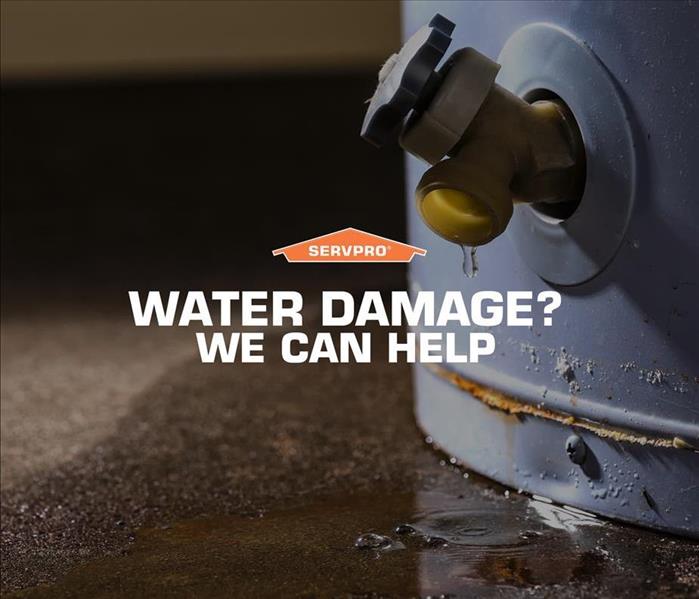 Water leaks in your home, whether from an appliance such as a leaky water heater or from a burst pipe, need to be addressed immediately.
Water leaks in your home, whether from an appliance such as a leaky water heater or from a burst pipe, need to be addressed immediately.
Close your eyes and imagine any one of the following scenarios:
- You were trying to turn off the water but your outdoor spigot handle breaks off. How do you turn off the water now?
- You turned on your dishwasher an hour ago. You've just returned to your kitchen -- and the floor is all wet. Seems a dishwasher supply hose burst. What's the first thing you do?
- You return home only to find that an overhead water pipe in your basement has burst, leaving a wet mess to be cleaned up. Where do you start?
- You've always taken for granted how a toilet flushes when you push the lever. Until one day you push to flush and the pipe collar behind the toilet cracks. Water is spraying everywhere. What now?
These are examples of real customer issues that SERVPRO of Glenview has responded to over the past few years. The different ways and the amount of water damage that can occur is mind-boggling.
When you are present at the moment it happens, what do you do first? If your first instinct is to stop the water, you're correct. But if the spigot handle is broken or the hose or pipe have burst, how do you stop the water?
You have to turn off the water source. You do this by either turning off the nearest water shut-off valve or by turning off the main shut-off valve, the valve that controls the water supply to your entire residence. However, you cannot turn off the valves if you don't know where they are!
Unfortunately, very few homeowners take the time to learn where the emergency shut-off valves are located in their home. Knowing where the valves are located and how to shut them off can save you precious time -- and untold damage -- at crucial moments during a water loss emergency.
Take the time to educate yourself where these shut-off valves are located. Most homes today have shut off valves in multiple locations, in addition to the main shut-off valve. Check beneath your sinks, behind your toilets, behind the washing machine, and even near your fridge. Chances are, you'll see a shut-off valve there!
Remember, lefty-loosey, righty-tighty! Educate yourself - and others in your household - on how to turn off the water in case of emergency! The sooner you stop the flow, the less chance there is for more severe water damage!
After you turn off the water at the nearest shut-off valve, then you can address the next issue: cleaning up the wet mess! If it's a small mess, certainly it can be cleaned up easily with towels or a wet-vac. But you might need to call in the pros for larger messes - call SERVPRO! And to take care of any burst pipes or broken faucets, be sure to contact your plumber to take care of that.
Being home when an accident happens is one thing, but what happens when you're not there to see it - or to react immediately? One way of preventing unexpected water damage from occurring when you will be away from home for longer periods of time, like a vacation, is to turn off the main shut-off before you leave.
No matter where you are when water damage occurs in your home, minimizing the damage is first priority - for you and for us. Should disaster strike, don't hesitate to call the professionals. Call SERVPRO of Glenview at 847-832-9300.
Water Emergency? Fast Response Time Is CRUCIAL!
3/11/2020 (Permalink)
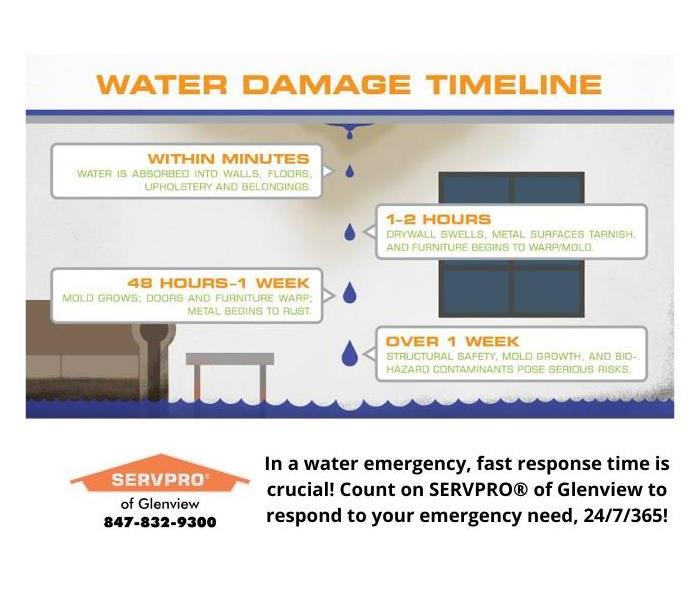 Water emergency??? DON'T DELAY!!! Call SERVPRO® of Glenview right away! Call 847-832-9300!
Water emergency??? DON'T DELAY!!! Call SERVPRO® of Glenview right away! Call 847-832-9300!
24 Hour Emergency Service
Being available 24/7 means we don't adhere to "regular" business hours. Why? Because water emergencies don’t wait for regular business hours! SERVPRO® Franchise Professionals provide emergency water restoration services every day of the year, 24 hours a day, 7 days a week—including all holidays. You can expect an immediate response time, day or night.
Need Emergency Service?
Call SERVPRO® of Glenview NOW: 847-832-9300
A Fast Response Is Crucial in Water Emergencies
In many cleaning and restoration situations, immediate action is essential. With over 1,700 U.S. and Canadian Franchise locations, SERVPRO is strategically positioned to be faster to any size emergency.
An immediate response helps to minimize the damage, the cleaning, and the restoration costs.
Water is particularly invasive, quickly spreading throughout your property as it's absorbed into floors, walls, furniture, your belongings, and more. Our SERVPRO® crew arrives quickly and starts the water extraction process almost immediately.
Water Damage Timeline
Do you know what happens in a water emergency? Say there's an emergency where an extensive amount of water is suddenly everywhere... your sump pump fails during a heavy rain, or your washer hose bursts in the middle of a wash cycle...
Within Minutes:
- Water quickly spreads throughout your property, saturating everything in its path
- Water is absorbed into walls, floors, upholstery, and belongings
- Furniture finishes may bleed, causing permanent staining on carpets
- Photographs, books, and other paper goods start to swell and warp
Hours 1 - 24:
- Drywall, heavy with the water it absorbed, begins to swell and break down
- Metal surfaces begin to tarnish
- Furniture begins to swell and crack
- Dyes and inks from cloth and paper goods spread and stain
- A musty odor appears
48 Hours to 1 Week:
- Mold and mildew may grow and spread, especially in prime conditions
- Doors, windows, and studs swell and warp
- Metal begins to rust and corrode
- Furniture warps and shows signs of mold
- Paint begins to blister
- Wood flooring swells and warps
- Serious biohazard contamination is possible
More Than 1 Week:
- Restoration time and cost increase dramatically
- Replacing contaminated materials and structural rebuilding may be extensive and costly
- Structural safety, mold growth, and biohazard contaminants pose serious risks to occupants
To minimize the initial water damage, secondary damage, and possible mold damage, you need to call on experts to mitigate the damage. Rest assured you can count on SERVPRO® of Glenview to respond to your emergency call. We are Here to Help!®
847-832-9300
Preventing Frozen Pipes
1/28/2020 (Permalink)
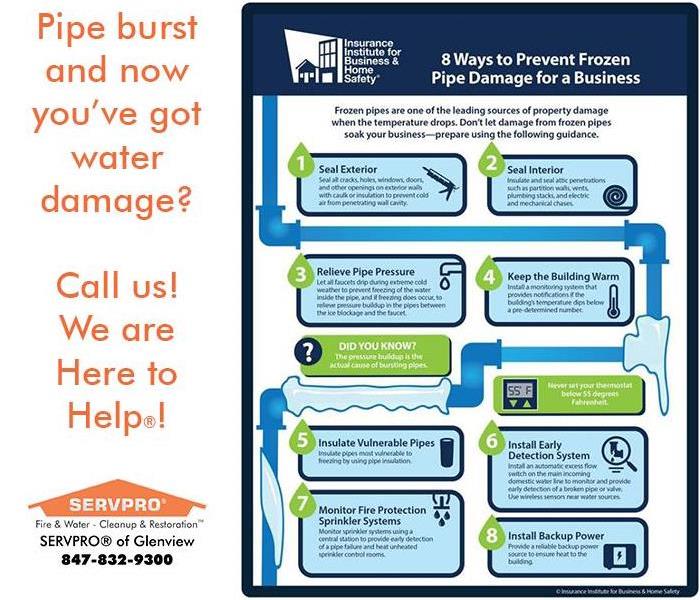 Home or business, protect your pipes from freezing!
Home or business, protect your pipes from freezing!
You can protect your home or business from winter weather by taking these actions suggested by the Insurance Institute for Business & Home Safety (IBHS). Their winter weather guidance can be found on their site, www.DisasterSafety.org.
Protect Homes or Businesses from Winter Weather: Preventing Frozen Pipes
1. Insulate and seal attic penetrations, such as partition walls, vents, plumbing stacks and electric/mechanical chases; insulate and seal wall cavities as well.
2. insulate pipes most vulnerable to freezing (in attic or in basement) by using pipe insulation.
3. Provide a reliable backup power source to ensure continuous power to your home.
4. Set reasonable temperatures - keep the thermostat at a reasonable temperature, even if you'll be away from home.
5. Install a temperature monitoring system that provides notifications if the building's temperature dips below a pre-determined number.
6. Install an automatic excess flow switch on the main incoming domestic water line to monitor and provide early detection of a broken pipe or valve; use wireless sensors near water sources.
7. Monitor sprinkler systems using a central station to provide early detection of a pipe failure and heat unheated sprinkler control rooms.
8. Let all faucets drip during extreme cold weather to prevent freezing of the water inside the pipe, and if freezing does occur, drips will relieve pressure buildup in the pipes between the ice blockage and the faucet.
9. Keep bathroom and kitchen sink cabinet doors open during cold spells to let warm air circulate around the pipes below the sink.
https://disastersafety.org/winter-weather/protect-your-home-from-severe-winter-weather/
Forewarned is Forearmed!
7/24/2019 (Permalink)
 Water damage??? No problem! We are #HereToHelp!
Water damage??? No problem! We are #HereToHelp!
Everyone has heard the proverb "Forewarned is forearmed" - which is just another way of saying that having prior knowledge of possible dangers or problems gives one a tactical advantage. Or put another way, being armed with information gives you the best chance of having a more positive outcome in a dangerous situation. We at SERVPRO® of Glenview would like to help you out - by arming you with information!
Summer storms are making grand appearances across the Midwest and here in our local area, several of the recent storms have caused damage. Among the more common types of damage severe storms can cause is flood damage. In homes, flooded basements can occur when the sump pump fails or breaks down.
Knowing what one should - and should not - do in this situation can help you best remain in control when storms cause water damage to your home.
Clean water damage is typically what most residents experience when their sump pump fails, because the water that floods their basement or lower level is "clean" - it is storm run-off water, as opposed to "dirty" water (sewage or waste water).
If you experience clean water flooding in your home, try to do the following as soon as possible, to minimize the water damage:
- Turn off circuit breakers for the wet areas, when access to the power distribution panel is safe from electrical shock.
- If you are able, remove water using a water vacuum (shop-vac) or pump and hose. Never use your household vacuum cleaner!
- Remove as much excess water as possible by mopping and blotting.
- Clear lamps and tabletop items so you can wipe excess water from wood furniture.
- Place aluminum foil or wood blocks between furniture legs and carpeting or wet floor.
- Remove and prop up wet upholstery cushions for even drying.
- Remove valuables to a safe, dry place; items such as paintings, art objects, computers, documents, and other materials which are sensitive to moisture should be removed from wet areas and begin drying as soon as possible to minimize damage.
- Lift draperies with coated hangers so they hang above wet carpeting or floors.
- Area rugs should be removed to a suitable drying area.
- Installed carpeting may need to be pulled up to remove a wet and damaged pad (which will need to be replaced). Depending on severity of water damage and length of time before any water removal is begun, it may also be necessary to remove and replace installed carpeting.
- Finished areas should be closely observed to monitor whether drywall, baseboards, and insulation in the walls has sustained any water damage. Not addressing water damaged walls can lead to serious and extensive mold damage, which is expensive to remove and possibly not covered by insurance!
When your home sustains clean water damage, it is also important to remember this list of dont's:
- Don't enter rooms with standing water where electrical shock hazards may exist.
- Don't enter affected areas if electrical outlets, switches, circuit breakers, or electrical equipment are exposed to water.
- Never use your household vacuum cleaner to remove water, as this can possibly cause electrical shock or even damage the vacuum cleaner.
- Don't use TVs or other electrical appliances while standing on wet carpets or floors, especially not on wet concrete floors.
- Don't turn on ceiling fixtures if the ceiling is wet. Don't enter rooms where ceilings are sagging from retained water - this sort of damage control is best done by professionals.
- Don't leave Oriental rugs or other colored area rugs on wet wall-to-wall carpets, as they can cause staining.
- Don't leave books, newspapers, magazines, or other colored items on wet carpets or floors, as they can cause staining.
- Don't leave cardboard boxes on wet floors or carpets as they will continue to absorb water.
A failed or broken sump pump during a severe storm can be the reason a basement floods, with 3" to 6" (or more!) of standing water not being uncommon. If you are able to take any of the above measures to help minimize clean water damage, then you are taking steps in the right direction.
If you are unable to address on your own any of the above issues - or possibly even others not mentioned, please don't hesitate to call SERVPRO® of Glenview at (847) 832-9300. As your local independently owned and operated Fire & Water - Cleanup & Restoration™ experts, we are always Here to Help®!
When fire and water take control of your life, we help you to take it back.
Find and like us on social media! We're on facebook and instagram!
Spring Showers ruining your hard wood floors?
5/21/2019 (Permalink)
 This flooded kitchen was caused by recent heavy rains.
This flooded kitchen was caused by recent heavy rains.
Heavy spring rains flooded a customer's home in Glenview causing the wood floors to buckle.
SERVPRO uses a system called Inject-a-dry to suck all the water up from the wood floors leaving it "Like it never even happened."
SERVPRO of Glenview was called in to do the water mitigation for this family to save their hard wood floors from ruin. The customers were so grateful that they referred us to all of their friends and family!
Water damage to your home? No worries!
5/14/2019 (Permalink)
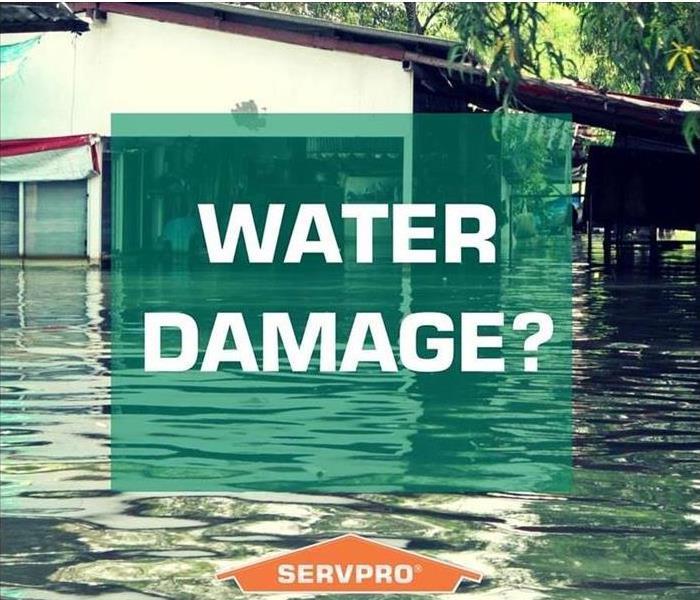 SERVPRO of Glenview is here to help with any water damage you may incur. From extreme rains to pipe breaks. We've got you covered!
SERVPRO of Glenview is here to help with any water damage you may incur. From extreme rains to pipe breaks. We've got you covered!
SERVPRO is here to help 24/7! Call us for all your water and fire damage needs!
Spring Break Water Damage
3/18/2019 (Permalink)
The amount of untold damage that a broken pipe can do is breath taking and that can be if you are there when it happens. How much initial damage and secondary damage will occur if you aren't there? What will happen and how long will it go on if you are gone on a Spring Vacation or out of town over the weekend?
Turning your water off before you leave for vacation or the weekend can seem like such a small and unlike preparation and yet that act alone can be the difference between avoiding disaster entirely or thousands or even tens of thousands of dollars in damage to your home or business.
Unfortunately, very few business and home owners take the time to learn where their emergency shut offs are, and only when the barbarians are at the gate does it become a necessity.
Take the time to educate yourself where these shut offs are and don't forget to shut the water off before you leave for prolonged periods of time. Should disaster strike, call the professionals. Call SERVPRO of Glenview.
847-832-9300
#WaterDamage #PipeBreak #InsuranceClaim #Restoration #Mitigation #BoardUp #FireDamage #SmokeDamage #SERVPROGLENVIEW
6 Ways to Prevent Water Damage This Winter
1/28/2019 (Permalink)
 Prevent Winter Water Damage from happening to you!
Prevent Winter Water Damage from happening to you!
6 Ways to Prevent Water Damage This Winter
If the worst happens, your homeowner’s insurance will cover leaks and burst pipes, or water that comes into your home through your roof and windows. But it doesn't cover flooding.
Q What can I do to avoid water damage this winter? I know my policy doesn't cover flooding, but does it pay for other types of water damage claims?
A Yes. Homeowners insurance covers water damage, such as from leaks and burst pipes, or water that comes into your home through your roof and windows. In fact, water damage accounts for almost half of all property damage claims, according to the Insurance Information Institute. Burst pipes or undetected leaks can cause damage to the floor, walls, ceilings, furniture, artwork and other valuables, can soak electrical systems, and can even cause dangerous mold if not cleaned up quickly. A Chubb study found that 57% of homeowners who have experienced a water leak claim in the past two years spent more than $5,000 on clean-up costs, and 15% spent $20,000 or more.
Here are six things you can do to protect your home from water damage, especially if you're leaving town during the winter.
- Install a water leak detection device. A minor water leak can cause expensive damage if it remains undetected—if the leak is behind a wall, say, or if it happens while you're away from home. The lowest-cost leak detectors include sensors you can set up under sinks or near a water heater, dishwasher or refrigerator; they sound an alarm if they detect any moisture. Leak detectors that cost a bit more (typically $50 to $80) will send an alert to your smartphone if they detect moisture or a big change in the amount of water used in your home (signaling a possible leak). Some sensors even monitor the flow of water to your house and can shut down the water valve automatically if there's a noticeable change in the amount of water used, which is particularly helpful if you travel frequently. Your home insurance company may offer a discount for installing some kinds of leak detection devices.
- Turn off the main water supply before leaving town for an extended period of time. That's the easiest and most cost-effective way to prevent water loss from happening. As an alternative, you could have someone check your house every few days and walk around to make sure there aren't any leaks.
- Check your water supply lines at least once a year. Give your house an annual leak checkup to inspect water supply lines and washing machine hoses for signs of wear. Check for leaks from your hot water heater, washing machine, ice machine in your refrigerator, and any other appliances that can leak. Most water supply lines tend to last for about five years; you may want to replace rubber hoses with steel-braided hoses, which tend to last longer.
- Get sewage-backup coverage. Heavy rains and melting snow can overburden the storm water system, causing water or sewage to back up into your house. Sewage and drain backups usually aren't covered automatically under your homeowner’s insurance, but it may cost only $50, say, to add $10,000 in coverage. Also consider having a battery-powered back-up for your sump pump if the electricity goes out.
- Clean your gutters and inspect your roof. Remove leaves and other debris, which can clog gutters and send water pouring down the side of your house or under your roof. Also inspect your roof and repair or replace missing or damaged shingles, which can cause water to come in through the roof.
- Protect your pipes from freezing. Insulate accessible pipes with pipe insulation materials, especially in attics and crawl spaces. When it gets very cold, keep cabinet or closet doors open to help prevent pipes there from freezing. Consider low-temperature detectors, which can send an alert to your smartphone if the temperature in areas of your home near pipes dips below freezing.
If winter water damage happens to you, remember that SERVPRO of Glenview is faster to any disaster. Call 847-832-9300!
Don't Let Water Damage Get Out of Hand!
10/9/2018 (Permalink)
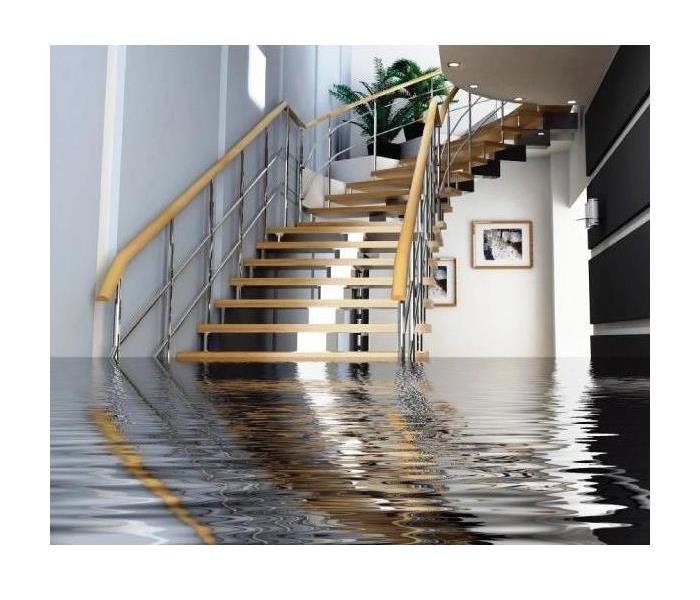 Make sure your home doesn't stay soggy after the flood.
Make sure your home doesn't stay soggy after the flood.
Flooding and water emergencies don’t wait for regular business hours and neither do we. SERVPRO of Glenview provides emergency cleaning and restoration services 24 hours a day, 7 days a week—including all holidays.
Faster To Any Size Disaster
Flooding and water damage is very invasive. Water quickly spreads throughout your home and gets absorbed into floors, walls, furniture, and more. SERVPRO of Glenview arrives quickly and starts the water extraction process almost immediately. This immediate response helps to minimize the damage and the cleaning and restoration costs.
Need Emergency Service? Call Us 24/7 - (847) 832-9300
Water Damage Timeline
Within Minutes
- Water quickly spreads throughout your property, saturating everything in its path.
- Water is absorbed into walls, floors, upholstery, and belongings.
- Furniture finishes may bleed, causing permanent staining on carpets.
- Photographs, books, and other paper goods start to swell and warp.
Hours 1 - 24:
- Drywall begins to swell and break down.
- Metal surfaces begin to tarnish.
- Furniture begins to swell and crack.
- Dyes and inks from cloth and paper goods spread and stain.
- A musty odor appears.
48 Hours to 1 Week:
- Mold and mildew may grow and spread.
- Doors, windows, and studs swell and warp.
- Metal begins to rust and corrode.
- Furniture warps and shows signs of mold.
- Paint begins to blister.
- Wood flooring swells and warps.
- Serious biohazard contamination is possible.
More Than 1 Week:
- Restoration time and cost increase dramatically; replacing contaminated materials and structural rebuilding may be extensive.
- Structural safety, mold growth, and biohazard contaminants pose serious risks to occupants.
About SERVPRO of Glenview
SERVPRO of Glenview specializes in the cleanup and restoration of residential and commercial property after a fire, smoke or water damage event. Our staff is highly trained in property damage restoration. From initial and ongoing training at SERVPRO’s corporate training facility to regular IIC
Water Damage! What Do I Do With My Soggy Stuff?
7/24/2018 (Permalink)
 A burst pipe? A broken sump pump? Now what?
A burst pipe? A broken sump pump? Now what?
We’ve all had it happen sometime in our lives. You walk into your basement after a rainstorm, check on that dripping sound coming from the kitchen, or go see why that odd noise is coming from the laundry machine and there it is: water flooding into your home. Sometimes the cause is obvious: a pipe leaks, a nasty flood outside creeps under a doorway, or the dishwasher starts pouring water onto the hardwood floor. However, something seemingly innocuous can lead to heavy damage as well. Areas prone to collecting water, like crawlspaces and basements, can slowly build up moisture and become a breeding ground for mold. Water damage, if not taken care of promptly, can lead to major catastrophes for home owners: mold can lead to health problems (death in the most extreme cases), furniture and other belongings can become permanently damaged, and even the foundation of a building can be weakened. If you’re concerned about any belongings stored in places prone to water damage, you can always place them in plastic bins. Make sure they’re elevated so that water coming in can’t reach them. Your items might seem safe in a basement, crawl space, or attic, but leaks and floods happen. Preventative measures can save you time, money, and stress.
So, what can you do about water damage? First and foremost, you should take lots of pictures and contact your insurance agency. They’ll want to see what happened before you’ve intervened to determine your coverage. The next step might seem obvious, but you should dry the area as much as possible. Mop it, lay towels on the area, do whatever you can to absorb as much water as possible, but avoid using electronic appliances. While this can help, water can seep into drywall, the floor, and other permeable objects. If this is the case, you’ll need to remove and replace these damaged areas. Sometimes it can be difficult to know just how much water has spread, as it can travel through floors and walls. A damp or moldy smell is a strong indicator that water seeped into the area, but you can also use a moisture meter, which you can buy online or at your local hardware store, to find areas that have been saturated. Of course, your local SERVPRO of Glenview can efficiently and effectively remove odors, damaged areas, and tough-to-get mold, leaving you safe and worry-free.
Electrical Safety. Don't Get Zapped!
5/30/2018 (Permalink)
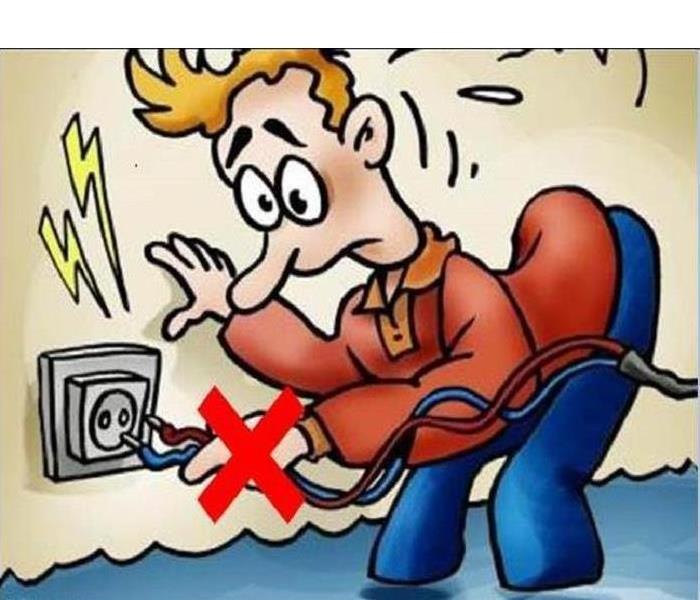 Water & electricity - a dangerous duo!
Water & electricity - a dangerous duo!
There are many risks associated with flooding. One of them is the danger associated with your electrical system. It is critically important to treat all electrical appliances, equipment and outlets with caution. Here are a few safety tips:
- Never step into standing water that has covered electrical outlets or devices-the water could already be charged with electric current.
- If there are downed power lines in your area, you should avoid them and notify your local power company.
- Avoid areas where there are sparks or if you hear popping or buzzing noises.
- If you smell something that resembles plastic burning, this could indicate an electrical fire.
After any flooding event, you should consult a certified electrician to determine the extent of damage to your electrical system.
Commercial facility with a Flood
11/13/2016 (Permalink)
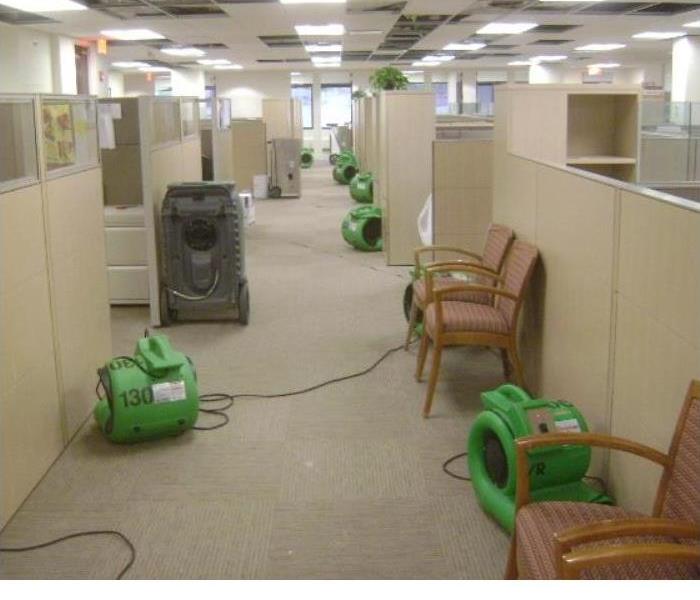 Glenview commercial facility being mitigated by Servpro of Glenview
Glenview commercial facility being mitigated by Servpro of Glenview
Flood and water damage occurs in the blink of an eye. Water damage is an unexpected event that can change the course of any business and its day to day operations causing much inconvenience. SERVPRO of Glenview has been called on to dry many commercial and industrial facilities after water damage has occured. While water damage may occur from such an incident, a quick and timely response may make the difference in preventing further secondary damage that may occur. Due to the damages there are generally occasions when air quality and temperature need to be maintained. SERVPRO of Glenview will step up to meet the challenges you face in getting your business up and running. We have the equipment to dry your commercial facility in a timely manner. In the event there is a need for specialty restoration equipment, support services are lined up so that we can meet those needs for you as well.
Glenview 24 Hour Emergency Water Damage Service
7/7/2016 (Permalink)
SERVPRO of Glenview is available 24 hours a day for water emergencies, large or small. When you are dealing with water damage, immediate action is crucial. A delay of just a few hours can greatly increase the severity of the water damage.
We Answer the Phone Ready to Help
Call Today – (847) 832-9300
We understand that when you call us, you may be feeling confused, stressed, and vulnerable. You need an expert to guide you through this crisis. SERVPRO of Glenview has the specificwater damage training and experience to help you through this tough time. We specialize in water damage restoration—in fact, it's the cornerstone of our business.
What to Expect
When you call, we will ask several questions regarding your water damage emergency. Thesequestions will help us determine what equipment and resources to bring, including how many trained SERVPRO Professionals may be needed.
Our SERVPRO Representative will ask several questions:
? Your name and contact information
? Your insurance information (if applicable)
? The street address of the water-damaged home or business
? When did the flooding or water damage occur?
? What caused the water damage (if known)?
? Is there electricity available (on-site)?
About SERVPRO of Glenview
SERVPRO of Glenview specializes in the cleanup and restoration of residential and commercial property after a fire, smoke or water damage event. Our staff is highly trained in property damage restoration. From initial and ongoing training at SERVPRO’s corporate training facility to regular IICRC-industry certification, rest assured our staff is equipped with the knowledge to restore your property.
How to Clean and Dry a Flooded Wilmette, IL Basement
4/30/2013 (Permalink)
 Wall and All Surface Cleaner is excellent for general cleaning.
Wall and All Surface Cleaner is excellent for general cleaning.
Properly cleaning and drying requires the right products and tools; at this Wilmette home with a flooded basement SERVPRO Wall and All Plus was selected for its ideal alkalinity. SERVPRO Wall and All Plus has a pH of 11-12.5 making it an excellent solvent for breaking down oils and organic dirt left behind from flooding without being overly corrosive like bleach and ammonia. Once the cleaning has been done, dehumidifiers and air movers will be used to dry everything out.
SERVPRO of Glenview was called in after the April 18th flooding event that hit the Chicagoland area to make this basement look "Just like it never even happened."
 A smart homeowner or business owner will always be prepared by learning where the shut-off valves are located
A smart homeowner or business owner will always be prepared by learning where the shut-off valves are located





 24/7 Emergency Service
24/7 Emergency Service













